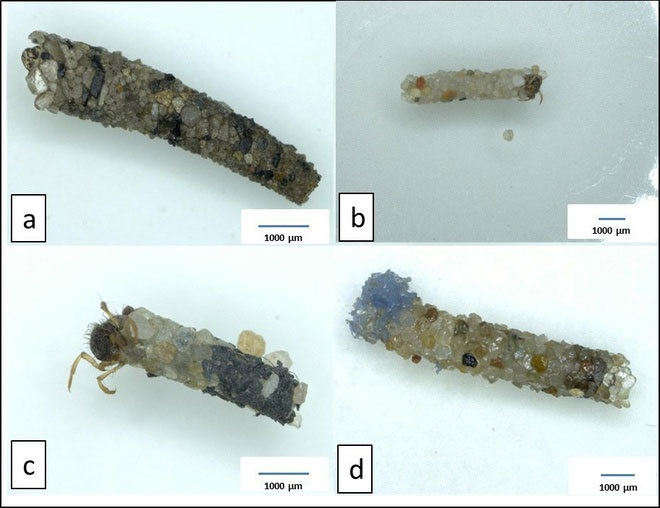Detecting insects helps people collect plastic waste
A larvae belonging to the Plumage Wing have adapted to environmental pollution, but this can be traded for their lives.
Insects often build cocoons with tiny crystals of sand. Recently, a team of biological researchers in Germany discovered a few cases of cocooning with microplastics, small pieces of plastic or other fibers that are visible to the naked eye.
The insect has the Lepidostoma basale family of the Feathers , widely found throughout Europe such as Britain, Germany and Spain. The larvae of this species usually live in tubular or conical cocoons built by them.
To understand the phenomenon, the research team of the German Hydrographic Institute brought some larvae to the laboratory and observed.
Specifically, the scientists collected all the surrounding habitats like spring water, leaves and even the piece of wood that the larvae are clinging to. They then placed them on a mixture of sand and two types of micro-plastic, including fine PVC particles.
Next, the scientists gently pushed the larvae out of the old cocoon, so that they soon created a new cocoon in the living conditions of the experiment.

Images of larvae are made entirely of sand (top row) and larvae are constructed from sand and microscopic particles (lower row). (Photo: Atlasobscura).
After 48 hours of completing the new cocoon, the results showed that 79% of the larvae had used the first micro plastic particles, then transferred to the sand.
"The reason may be because micro-plastic particles are lighter than sand, which makes it easier for larvae to use this material to wrap their fragile bodies," said Sonja Ehlers, a member of the research team.
However, the researchers found that the micro plastic pod pod is less stable than the sand cocoon. In addition, the plastic casing has a colorful color, no camouflage, increasing the chances of larvae being eaten by dragonflies and other fish.

Micro-plastic pods with striking color scheme, no camouflage, increase the likelihood of larvae being eaten. (Photo: Atlasobscura).
L.basale insects help to clean up aquatic ecosystems like wood chips and algae. This species is also food for bats, frogs . "The effect of the plumage can affect the whole ecosystem," Matt Simon wrote in Wired magazine.
Researcher Ehlers was concerned about the influence of microscopic particles on terrestrial insects, such as termites. Ehlers also wanted to find out if the plastic could release toxins or affect the larvae living around.
While scientists continue to find answers to the correlation between microplastics and the growth of insects, the best way to protect the species is to limit waste to the environment. .
- Germany will collect plastic waste on the sea
- How long does it take for plastic waste to decompose?
- Tragedy: Whales are eating hundreds and thousands of plastic trash every day
- The danger of the ocean
- Vietnam is the top 5 countries that discharge most plastic waste into the sea
- Why is plastic garbage so difficult to decompose?
- Turning plastic into petroleum: 2-in-1 solution for plastic waste
- What happens to a plastic bottle after being thrown into the trash?
- Turn waste plastic into jet fuel
- For the first time Vietnam built roads from plastic waste
- Alarm plastic trash appears in the fry
- The end of the era of plastic garbage is probably coming soon, thanks to this invention
 Why do potatoes have eyes?
Why do potatoes have eyes? 'Tragedy' the world's largest carnivorous life: Death becomes ... public toilet
'Tragedy' the world's largest carnivorous life: Death becomes ... public toilet Tomatoes were once considered 'poisonous' for 200 years
Tomatoes were once considered 'poisonous' for 200 years Detecting microscopic parasites on human face
Detecting microscopic parasites on human face